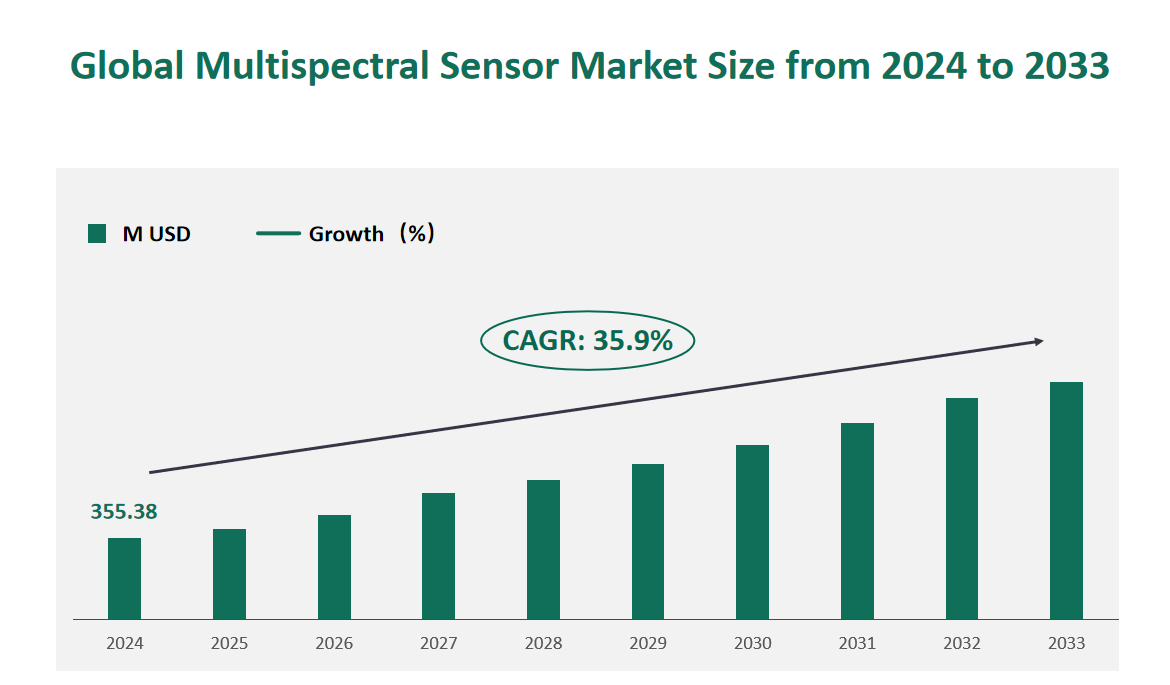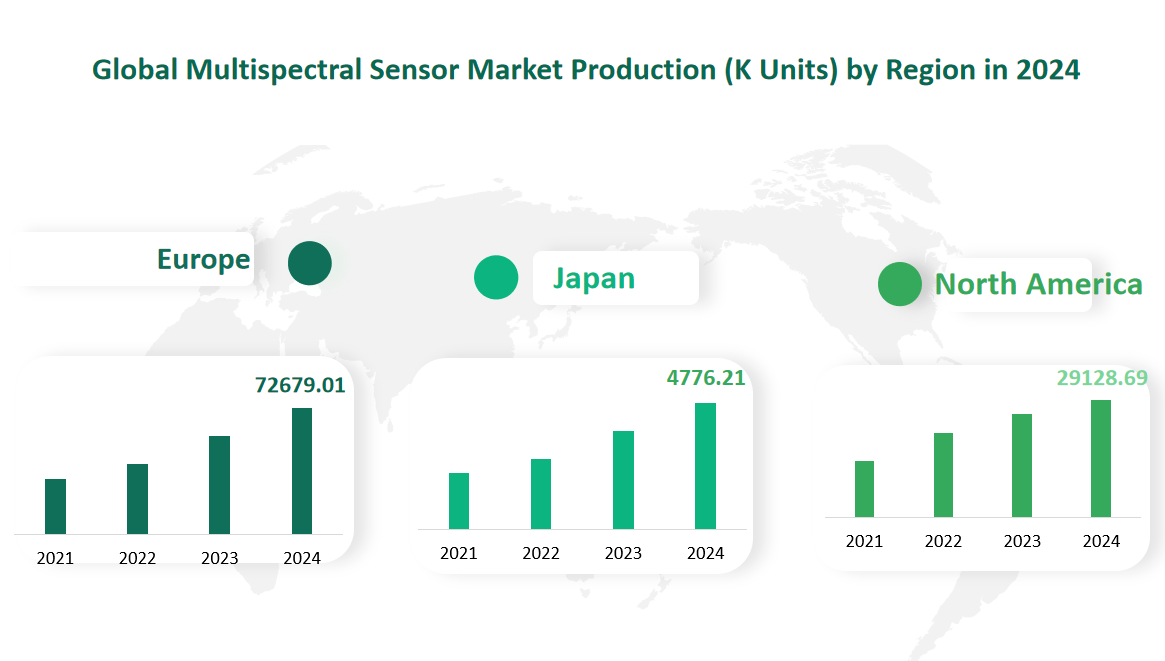1 Global Multispectral Sensor Market Size (Value) and CAGR (2024-2033)
In 2024, the global Multispectral Sensor market was valued at USD 355.38 million, with a CAGR of 35.9% from 2024 to 2033.
Multispectral sensors are sophisticated devices that capture images in multiple wavelengths, beyond the visible spectrum. They are capable of detecting and measuring the reflection of light energy off objects in the environment, providing valuable data for a wide range of applications. These sensors are essential in fields such as remote sensing, where they help in monitoring and analyzing environmental changes, and in precision agriculture, where they assist in optimizing crop management and yield.
Figure Global Multispectral Sensor Market Size (M USD) and CAGR 2024-2033

2 Multispectral Sensor Market Drivers and Industry Trends
One of the primary drivers is the increasing demand for advanced imaging technologies across various sectors. As industries such as aerospace, agriculture, and industrial manufacturing continue to evolve, the need for precise and detailed data has become more critical. Multispectral sensors, with their ability to capture images in multiple wavelengths, provide valuable insights that traditional sensors cannot offer. This has led to a growing adoption of multispectral sensors in applications ranging from environmental monitoring to precision agriculture, where they help in optimizing crop yields and managing resources more efficiently.
Another significant driver is the ongoing technological advancements in sensor technology. The development of more accurate and versatile multispectral sensors has expanded their potential applications. For instance, the integration of multispectral sensors with drones has revolutionized data collection in hard-to-reach areas, making it possible to gather detailed information quickly and efficiently. This has not only improved the quality of data but also reduced the time and cost associated with traditional data collection methods.
The trend towards miniaturization and integration of sensors into various systems is also a key industry trend. As devices become smaller and more powerful, multispectral sensors are being designed to fit into compact spaces without compromising on performance. This has opened up new opportunities for their use in consumer electronics, mobile devices, and other portable systems.
3 Multispectral Sensor Market Challenges
Despite the promising growth prospects, the multispectral sensor market faces several challenges and restraints that could impact its expansion. One of the primary challenges is the availability of substitutes. Hyperspectral imaging systems, for example, offer a higher level of spectral resolution, which can limit the market share of multispectral sensors. Hyperspectral sensors can identify and quantify molecular absorption, providing more detailed information than multispectral sensors. This capability makes them a preferred choice in certain applications, such as material identification and environmental monitoring, where high spectral resolution is crucial.
Rising labor costs in developed countries, where most multispectral sensor manufacturers are located, is also a restraint. High labor costs increase the operating expenses for manufacturers, which can lead to higher product prices. This may make multispectral sensors less competitive in price-sensitive markets, potentially limiting their adoption.
Fluctuations in raw material prices are another factor that poses a challenge to the market. The cost, availability, and quality of commodities and components used in the manufacturing of multispectral sensors can be volatile. Changes in global supply and demand, regulatory changes, and geopolitical factors can lead to price increases or supply interruptions. These fluctuations can impact the profitability of manufacturers and their ability to meet customer demand.
4 Global Multispectral Sensor Market Size and Share by Type in 2024
Universal Multispectral Sensors are designed for a wide range of applications across multiple industries. These sensors are versatile and can be integrated into various systems, making them a popular choice for many businesses. In 2024, the revenue generated by Universal Multispectral Sensors is projected to be significantly higher than that of Dedicated Multispectral Sensors. The revenue for Universal Multispectral Sensors in 2024 is forecasted to reach 203.81 M USD. This type of sensor is characterized by its ability to capture data across a broad spectrum of wavelengths, making it suitable for applications such as environmental monitoring, precision agriculture, and industrial quality control.
Dedicated Multispectral Sensors are designed for specific applications and are optimized to perform particular tasks. These sensors are used in scenarios where high precision and specialized data collection are required. In 2024, the revenue for Dedicated Multispectral Sensors is expected to be 151.57 M USD. Dedicated Multispectral Sensors are often used in aerospace, where they provide critical data for satellite imagery and space exploration. They are also used in medical imaging, where their ability to capture specific wavelengths can aid in the diagnosis of diseases.
Table Global Multispectral Sensor Market Size and Share by Type in 2024
Market Size (M USD) 2024 | Market Share 2024 | |
Dedicated Multispectral Sensor | 151.57 | 42.65% |
Universal Multispectral Sensor | 203.81 | 57.35% |
5 Global Multispectral Sensor Market Consumption (K Units) and Share by Application in 2024
The aerospace sector is one of the primary consumers of multispectral sensors. In 2024, the consumption is forecasted to be 11,083.12 K Units. Aerospace applications require high-precision sensors for satellite imagery, space exploration, and aircraft monitoring. These sensors provide critical data for weather forecasting, climate studies, and Earth observation, enabling scientists and researchers to better understand global environmental changes.
The industrial sector is a major user of multispectral sensors, with a consumption forecast of 51,468.02 K Units in 2024. These sensors are used in quality control, process monitoring, and material analysis. They help in detecting defects, optimizing production processes, and ensuring product quality, making them essential for industries such as manufacturing, mining, and construction.
The optics industry also relies heavily on multispectral sensors, with a consumption of 31,523.01 K Units in 2024. These sensors are used in the development and testing of optical systems, ensuring that lenses, mirrors, and other optical components meet high standards of performance. They are also used in applications such as spectroscopy and optical communication, where precise measurement of light properties is crucial.
Table Global Multispectral Sensor Market Consumption (K Units) and Share by Application in 2024
Application | Market Consumption (K Units) 2024 | Market Share 2024 |
Aerospace | 11083.12 | 9.63% |
UAV(Unmanned Aerial Vehicle) | 66.96 | 0.06% |
Industrial | 51468.02 | 44.72% |
Optics | 31523.01 | 27.39% |
Others | 20948.38 | 18.20% |
6 Global Multispectral Sensor Market Production (K Units) by Region in 2024
North America is a significant producer of multispectral sensors, with a production forecast of 29,128.69 K Units in 2024. The region is home to many leading technology companies and research institutions, which drive innovation and demand for advanced sensors. The United States, in particular, is a hub for aerospace and defense industries, which are major consumers of multispectral sensors. The region’s strong industrial base and technological prowess make it a key player in the global market.
Europe is the largest producer of multispectral sensors, with a production forecast of 72,679.01 K Units in 2024. The region has a well-developed research infrastructure and a strong presence in the aerospace, automotive, and industrial sectors. European countries such as Germany, France, and the United Kingdom are leaders in sensor technology, contributing significantly to the global market. The region’s focus on innovation and high-tech manufacturing ensures a steady demand for multispectral sensors.
Japan is a key player in the multispectral sensor market, with a production forecast of 4,776.21 K Units in 2024. The country is known for its advanced technology and high-quality manufacturing capabilities. Japanese companies are leaders in the development of precision sensors for various applications, including aerospace, automotive, and consumer electronics. The country’s focus on innovation and quality ensures a strong market position in the global landscape.
Figure Global Multispectral Sensor Market Production (K Units) by Region in 2024

7 Major Players in Global Multispectral Sensor Market
7.1 ams AG
Company Profile:
ams AG, established in 1981 and headquartered in Austria, is a leading designer and manufacturer of advanced sensor solutions. The company offers a broad range of technology solutions for consumer electronics and communication device manufacturers. ams AG’s products include sensor ICs, interfaces, and related software for consumer, communications, industrial, medical, and automotive markets.
Business Overview:
ams AG focuses on providing high-quality, innovative sensor solutions that address the needs of various industries. The company’s strategic ambition is to be a global leader in sensor solutions and photonics for mobile and consumer applications, as well as for automotive, industrial, and medical sectors. In 2020, ams AG completed the acquisition of Osram Licht AG, a significant move that strengthened its position in the market.
Product Portfolio:
ams AG’s product portfolio includes the AS7341, an 11-channel spectrometer for spectral identification and color matching applications. This sensor features 8 optical channels distributed over the visible range, 3 extra channels (Clear, Flicker, and NIR channel), and 6 parallel ADCs for signal processing. The ultra-low-profile package (3.1mm x 2mm x 1mm) makes it highly compact and cost-effective.
2022 Financials:
In 2022, ams AG reported a production of 16,873.49 K Units, with a revenue of 45.07 M USD. The gross margin was 59.94%.
7.2 Parrot
Company Profile:
Parrot, founded in 1994 and headquartered in France, is a leading drone company. The company’s mission is to move the industry forward with new standards for drones at work. Parrot provides best-in-class technology for inspection, first responders, firefighters, search-and-rescue teams, security agencies, and surveying professionals.
Business Overview:
Parrot is known for its innovative and high-quality drone systems and solutions. The company’s products are designed to meet the needs of various professional applications, from agriculture to security. Parrot’s commitment to innovation and quality has made it a trusted name in the drone industry.
Product Portfolio:
Parrot’s multispectral sensor portfolio includes the Parrot Sequoia, a comprehensive and adaptable solution compatible with all types of drones. The Parrot Sequoia+ analyzes plant vitality by capturing the amount of light absorbed and reflected by plants, providing valuable data for farmers to optimize their fields.
2022 Financials:
In 2022, Parrot reported a production of 7.22 K Units, with a revenue of 14.26 M USD. The gross margin was 45.44%.
7.3 MicaSense
Company Profile:
MicaSense, established in 2014 and headquartered in the USA, is a leading provider of agricultural remote sensing solutions. The company offers multispectral cameras optimized for use in small unmanned aircraft systems and on manned aircraft, providing multi-band data for agricultural remote sensing applications.
Business Overview:
MicaSense is dedicated to helping growers and agronomists detect areas of stress in crops and manage these issues immediately. The company’s products enable precise application of nutrient inputs and disease preventative actions based on actual field conditions, making them essential tools for modern agriculture.
Product Portfolio:
MicaSense’s product portfolio includes the RedEdge-MX, a rugged professional multispectral sensor with a metal housing. The RedEdge-MX is equipped with MicaSense’s next-generation light sensor DLS 2, providing more accurate and reliable data, which significantly reduces post-processing time.
2022 Financials:
In 2022, MicaSense reported a production of 4.05 K Units, with a revenue of 12.19 M USD. The gross margin was 47.07%.

